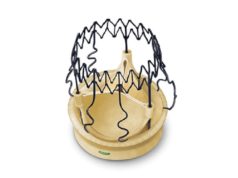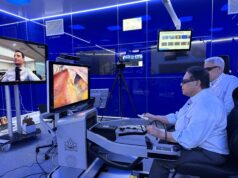At the 64th Annual Scientific Session & Expo of the American College of Cardiology (ACC), (14-16 March, San Diego, USA) Siemens Healthcare offered solutions for sustainable cardiovascular care that help ensure “more cardiology, less heartache”—the theme of this year’s booth. Siemens offered a portfolio of systems and support solutions ranging from imaging modalities to information technology to in vitro diagnostics,.
One solution, the Artis one angiography system, is designed to address a broad range of routine interventions. Enjoying positioning flexibility similar to ceiling-mounted systems, the floor-mounted system accommodates full head-to-toe coverage of patients up to 6 feet, 10 inches without the need for patient repositioning. The Artis one’s Clearstent Live application freezes motion in the stent region, allowing the physician to mask out movement of the beating heart and place the stent in precisely the correct position. Additionally, the Artis one offers the HeartSweep tool for cardiac imaging, which uses dual-axis rotational angiography to image the entire heart in one C-arm movement. With HeartSweep, users no longer need to obtain multiple acquisitions from different projections, instead enjoying a previously unprecedented level of flexibility in controlling the sweep of the C-arm arc.
The new Pure platform for Siemens’ Artis zee, Artis Q, and Artis Q.zen angiography systems is designed to simplify the adoption and utilisation of advanced features by adding smooth use to existing smart technologies while maintaining high standards in image quality and dose reduction. For 3D acquisitions, the 3D Wizard feature enables the user to click on the desired resultant image type from multiple model images for each part of the body. It automatically predefines all necessary parameters—including amount and injection rate of contrast fluid, X-ray delay, and other specifications—to create a 3D image. The QuickZoom feature allows physicians to click on the point of interest on syngo DynaCT images, which is then locked automatically into the centre of the image while rotating the 3D dataset or adjusting the zoom factor with a simple joystick motion. The syngo 2D/3D Fusion feature enables fusion of a preprocedural volume (computed tomography (CT)), magnetic resonance imaging (MRI), or positron emission tomography (PET]) utilising just two fluoroscopic images for live image guidance.
The ACUSON SC2000 ultrasound system PRIME enables users to perform real-time, full-volume colour Doppler, 3D transoesophageal ultrasound (TEE). The system provides real-time information in the operating room—even on patients with arrhythmia—to support a faster, more precise surgical workflow, optimise patient outcomes, and minimise risk. Full volume colour Doppler and automated aortic and mitral valve measurements provided by Siemens’ eSie Valves quantification software allow surgeons to visualise cardiac anatomy and assess blood flow during procedures, helping them make informed decisions.
syngo Dynamics VA10B, the latest version of Siemens’ cardiovascular imaging and information system, boosts non-invasive and invasive cardiovascular reading and reporting workflows, allowing cardiologists to focus on clinical care rather than spend time with reporting. syngo Dynamics offers enhanced integration with Siemens Sensis haemodynamic monitoring system, enabling customers to benefit from a workflow for cardiac catheterisations. syngo Dynamics’ integration capabilities optimise clinical utilisation and productivity, and enable support of enterprise-wide cardiovascular care initiatives.
Siemens’ syngo Ultrasound Apps Suite is an advanced offline cardiology analysis package integrated with an institution’s picture archiving and communications system (PACS). Integrated with syngo Dynamics, syngo Ultrasound Apps Suite improves user productivity without requiring additional offline hardware. It includes as an offline option the one-click eSie Valves quantification software, which was introduced last fall on Siemens’ ACUSON SC2000 PRIME cardiovascular ultrasound system. eSie Valves improves diagnostic accuracy during diagnostic echo as well as valve interventions such as aortic and mitral valve repairs. Other clinical applications available on syngo Ultrasound Apps Suite include eSie LVA for automated left ventricular analysis and eSie PISA for assessment of mitral regurgitation.
In cardiovascular imaging, acquisition speed is inextricably linked to image quality and subsequently a more confident diagnosis. Siemens’ SOMATOM Force dual-source computed tomography (CT) system enables cardiac imaging in less than a single heartbeat (average at-rest heart rate is 60–100 bpm and SOMATOM Force employs a .25 sec rotation). Additionally, the system provides high temporal resolution throughout the entire image. As the data is natively measured, Siemens does not need to artificially enhance the temporal resolution. Together with the new Vectron tube and StellarInfinity detector, the SOMATOM Force facilitates freezing motion at outstanding image quality. The Vectron tube’s power reserves allow healthcare providers to perform adult cardiac imaging at 70kV energy levels, enabling imaging at a lower radiation dose. The SOMATOM Force is ideal for cardiac imaging due to its unique Dual Source technology and 0.25-second rotation speed, which enables the system to image the heart in a quarter of a second. When combined with Turbo Flash Spiral and extended detector coverage (full 50cm field of view), the SOMATOM Force can image at speeds up to 737mm/s, enabling free-breathing CT exams for a broader range of patients. In combination, these features make the SOMATOM Force useful in detecting early signs of coronary heart disease.
Nuclear cardiologists who use Siemens’ Symbia Intevo xSPECT system can reduce the length of imaging protocols with IQSPECT, a field-upgradeable hardware and software combination that enables the reduction of imaging time from 16 minutes to 4 minutes, or up to 75% less injected dose. These shortened exams allow a sustainable approach to nuclear cardiology that enables improved acquisition time and reduced patient dose without compromising high-quality diagnostic information.
Siemens’ Biograph mCT Flow positron emission tomography/computed tomography (PETCT) system helps assess coronary artery disease (CAD) and heart damage as well as differentiate healthy muscle from damaged muscle. Biograph mCT Flow provides automated, rigid registration of CT and PET during cardiac imaging. A proprietary algorithm identifies the heart and aligns the two images for optimal attenuation correction, improving workflow and reducing user variability. The system allows the user to verify PET/CT registration accuracy in either patient (transverse/sagittal/coronal) or cardiac (SA/VLA/HLA) orientation. Biograph mCT Flow helps the user automatically detect respiratory motion during cardiac studies, enabling dual-gated PET with cardiac-gated list mode acquisition for optimal motion-frozen imaging, offline histogramming, and reconstruction.
Siemens developed the Cardiac Dot (day optimising throughput) Engine to reduce the complexity of cardiac MRI and to increase productivity by guiding the user through cardiac exams. The Cardiac Dot Engine automatically selects customised protocols based on the patient’s clinical condition. Through user guidance, patient personalisation, and exam automation provided by Cardiac Dot workflow technology, users can increase productivity in the healthcare setting as much as 50%.
A comprehensive portfolio of assays such as cTnI, BNP, NT-proBNP, and CardioPhase hsCRP helps manage patients throughout the continuum of cardiovascular disease. Siemens offers troponin testing on several of its core testing platforms, including ADVIA Centaur systems, Dimension Vista systems, and Dimension EXL systems, and provides consistent results by offering true clinical concordance between the point of care and central laboratory for guideline-compliant sensitive cardiac troponin. The Stratus CS Acute Care Diagnostics System provides quantitative cardiac assays for evaluation of patients presenting with acute myocardial infarction at the point of care. These assays include the Stratus CS Acute Care Troponin I method (cTnl), which, by helping to improve the diagnostic accuracy and rapid detection of acute myocardial infarction, facilitates earlier detection of myocardial injury, enabling more rapid diagnosis and faster initiation of appropriate therapy.










